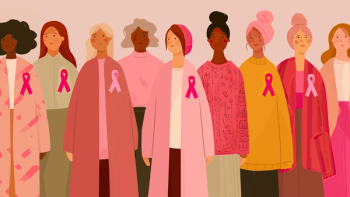
How I'm Handling Pinktober This Year
Pinktober heralds the arrival of so much pink that some of us run screaming from the sight of it, despite the good intentions of Breast Cancer Awareness Month. As I explain how I have made my peace with pink, you might feel better about your own choices.
Pink, pronounced "pingk," is a simple word: one morpheme, one syllable, four graphemes (letters). Even the internal vowel sound is a simple monophthong, although sometimes I speak the word to see if it is influenced by my southern drawl to include a diphthong. With the right intonation, "pink" does take on a twang.
While the origin of the word is not certain, according to "Oxford English Dictionary," it likely entered the English language as a word for a color (some combination of red and white) because of the pink flower family. As I have learned on hikes with naturalists, the flowers of this Dianthus family need not be colored pink. There are pink, red and white pinks in the natural world.
"Pink" in the world of flowers means that the edges of petals are frilly, as if cut by what we call pinking shears. The roots of the color pink thus intersect with the notion of frilly at the same time they remind us of the vibrant hues nature gives humans to imitate in our attire (or hair).
I like pink. I have always liked pink. While the first dress my mother stitched me was the palest of blues, a color associated with little girls in a bygone era, there is also in a drawer a pink-dotted Swiss dress she made. If I look at a quilt we constructed of fabric from years of dresses, pink is a prominent color.
Even now, as I write, I am wearing a frilly shirt with an abstract pattern of shades of pink (from fuchsia to mauve) and frilled cuffs. Wearing pink does not mean I am trying to look like a 6-year-old while 60-plus. Colors have vibes. When wearing pink, I feel comfortable. I feel vibrant. Once when I was not wearing pink, a friend told me that my aura is pink.
Pink can signify more than a flower, color or aura. Employing pink to mean something other than pink goes back many years. According to “Oxford English Dictionary,” the word pink was used as a noun, meaning "the most excellent example of something." This lovely meaning evolved to give us the idiomatic saying “in the pink,” “the most perfect condition or degree of something; the highest or most desirable state.”
There is a reason that Ladies’ Home Journal noted in 1918 that, "the generally accepted rule is pink for the boy and blue for the girl." The advice column further stated, "The reason is that pink being a more decided and stronger color is more suitable for the boy, while blue, which is more delicate and dainty, is prettier for the girl." (Remember my first dress? Remember the women's liberation movement?)
Trends change. Pink is now paired more often with girls (though my small son wore it some). It is for that reason, I think, that pink has become ubiquitous with breast cancer, which is often a woman's disease. This association with pink has become sweet and colorful as well as commercially suspect or sickeningly sweet, especially in October, Breast Cancer Awareness Month.
Pink was popularized through the work of the Susan B. Komen Breast Cancer Foundation, I think, with clothes and trinkets preceding pink ribbons. Inspired by a red ribbon denoting AIDS activism, the cancer community introduced pink ribbons. The rest is history. Now, in fact, October is to some “Pinktober,” a month with so much pink that one is likely to become overwhelmed. Because both my mother and I started breast cancer treatment in Pinktober, you can imagine how much pink stuff I have been exposed to over the years.
I am not much into consumerism. I do, however, cherish some pink-ribboned pens I bought over the years. While 10 cents per pen did go to City of Hope for cancer research, I selected the pens mostly because they were pink.
Sometimes all this pink gets unruly. Sometimes it disguises scams. Sometimes it makes us want to take our pink teddy bears and dip them in brown dye. Sometimes it makes us want to remember that breast cancer is more than a pink ribbon.
We all get to make our own decisions about Pinktober. One year, I went the whole month without wearing pink to protest the pinkification of breast cancer. This year, I have decided to wear my pink clothes proudly, but I am going to go with the idea that all my pink means that I am "in the pink." Pink is a good color for survivors.




